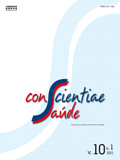Clinical and radiographic analysis before and after conservative treatment in adolescent idiopathic scoliosis: a case study
DOI:
https://doi.org/10.5585/conssaude.v10i1.2416Keywords:
Physiotherapy (techniques), Posture, Scoliosis.Abstract
Introduction: Idiopathic Adolescent Scoliosis (IAS) is a disease of unknown cause and diagnosed in individuals at the age of 10 years or over. The base of the treatment is a reliable assessment, including medical history, physical examination and radiographs. The clinical evaluation includes Adams test, postural analysis and calculation of the Cobb’s angle. Objective: To analyze clinical and radiographic changes before and after conservative treatment in patient with IAS. Methods: The resources used were therapeutic techniques for isostretching, manual therapy and thoracolumbar sacral orthosis. Results: After 30 sessions of physiotherapy, the results were analyzed by a comparison of ratings pre and post treatment, and the parameters used were the results of Adams test, Cobb’s angle and photographic assessment. The patient presented the gibbosity reduction in Adams test, decrease of Cobb angle of 6 degrees and postural improvement. Conclusion: The conservative treatment of IAS achieved significant clinical and radiographic results.Downloads
Downloads
Published
2011-03-31
How to Cite
1.
Cardoso LR, Gonçalves C, Bonvicine C, Barboza MAI. Clinical and radiographic analysis before and after conservative treatment in adolescent idiopathic scoliosis: a case study. Cons. Saúde [Internet]. 2011 Mar. 31 [cited 2025 Jun. 20];10(1):166-74. Available from: https://periodicos.uninove.br/saude/article/view/2416
Issue
Section
Cases studies
License
Copyright (c) 2011 ConScientiae Saúde

This work is licensed under a Creative Commons Attribution-NonCommercial-ShareAlike 4.0 International License.
Views
- Abstract 421
- PDF (Português (Brasil)) 855








